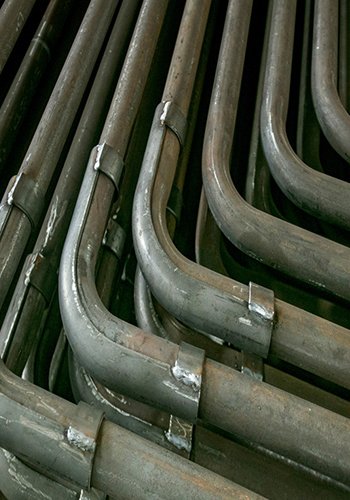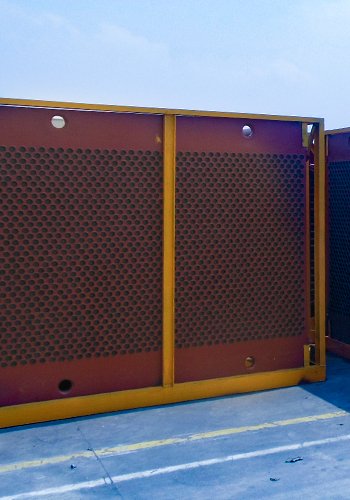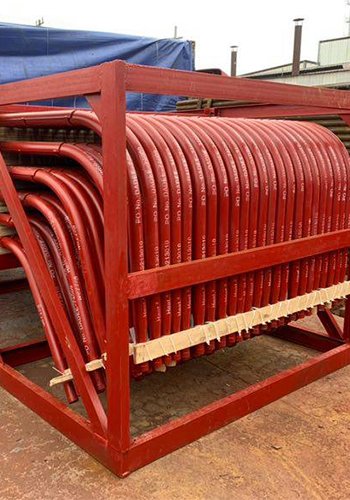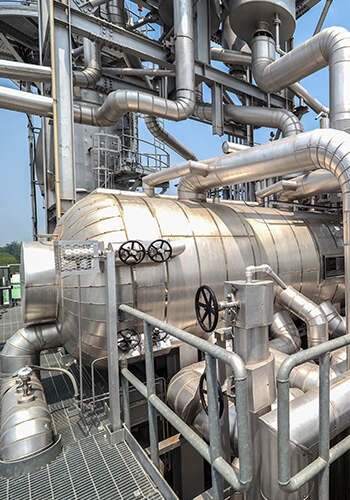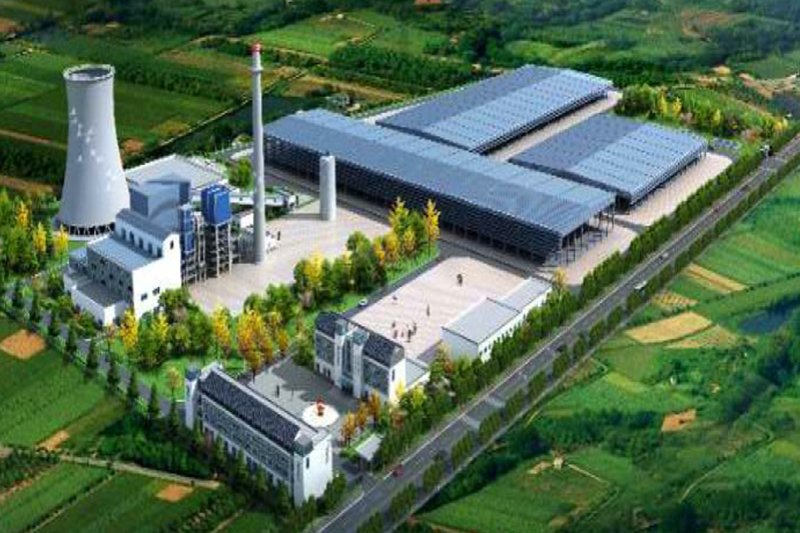Abstract: This article combines the structure and operating characteristics of a circulating fluidized bed boiler and starts from the monitoring of the feed water and boiler water operation of the circulating fluidized bed boiler to discuss the causes, hazards and solutions of boiler drum scaling.
Equipment Introduction
- Manufacturer: Harbin Boiler Factory
- Boiler Model: HG220/9.8 – L.YM27 high-temperature and high-pressure circulating fluidized bed boiler
- Boiler Type: Single drum natural circulation, single furnace, balanced ventilation, high-temperature cyclone separator, self-balancing U-shaped sealed return valve, tight enclosure arrangement, all-steel furnace frame suspension method, solid slag discharge, water-cooled drum slag cooler
- Boiler Capacity and Parameters:
- Maximum continuous evaporation of superheated steam: 220t/h
- Steam pressure at the outlet of superheated steam: 9.81MPa
- Steam temperature at the outlet of superheater: 540℃
- Feed water temperature: 215℃
- Air preheater type: Horizontal tubular air preheater
- Inlet air temperature: 35℃
- Primary air hot air temperature: 190℃
- Secondary air hot air temperature: 190℃
- Exhaust gas temperature: 146℃
- Boiler efficiency: 90.5%
- Desulfurization efficiency: >80%
- Calcium-sulfur ratio (Ca/S): 2
Boiler Unit Production Process
The main production process of the boiler unit is as follows: Chemically self-made demineralized water is used as make-up water, the drain of the boiler drain tank and the steam return water in the unit area form the boiler feed water. The above three water sources are deoxygenated by a low-pressure deaerator and a high-pressure deaerator and then pressurized to 13.5-15MPa by a feed water pump. They enter the drum through the boiler economizer. The furnace and various heating surfaces absorb the heat released by fuel combustion to produce high-temperature and high-pressure steam, which is sent to the steam turbine generator unit to do work and generate electricity. Among them, the steam return water in the unit area accounts for 60% or more of the boiler feed water.
Analysis of the Causes of Boiler Drum Scaling
In 2023, during the routine annual inspection of a boiler in a power plant, a large amount of scale was found in the drum, and there was attached scale on the inner wall of the drum and on the grid, etc. (Figure 1a, b). It was visually observed as a red scale-like substance.

- (1) Influence of Self-made Demineralized Water
The self-made demineralized water source of the plant comes from the Songhua River. After pretreatment, it enters a laminated filter + cation bed + anion bed + mixed bed for secondary desalination and water production, and the pH value is adjusted by adding ammonia. By consulting the operation reports in recent years, the quality of the demineralized water is within the design specification standards, and there is no over-standard operation phenomenon (see Table 1). Therefore, the cause of the demineralized water can be excluded.
| Serial Number | Project | Unit | National Standard GB/T12145 | 2022 Average Value |
| 1 | Silica dioxide at the outlet of the mixed bed (at the inlet of the demineralized water tank) | g/L | ≤20 | 4.7 |
| 2 | Conductivity at the outlet of the mixed bed (at the inlet of the demineralized water tank) | μs/cm | ≤0.2 | 0.07 |
| 3 | pH value of demineralized water | 8.8 – 9.3 | 9.25 | |
| 4 | Silica dioxide of demineralized water | μg/L | ≤20 | 4.5 |
| 5 | Conductivity of demineralized water (at the outlet of the tank, before adding ammonia) | s/cm | ≤0.4 | 0.08 |
- (2) Influence of Chemicals
The boiler drum of the plant mainly uses trisodium phosphate to adjust the pH value of the boiler water and prevent scaling. According to the requirements of DL/T805.2 – 2004, for boilers with a drum pressure of 5.9-15.8MPa, the purity of the phosphate should be of chemical pure or above grade. By consulting the inspection reports of the chemicals entering the factory, they are all qualified, and all indicators are within the required range. Therefore, the cause of the chemicals can be excluded. - (3) Influence of Boiler Blowdown
When the boiler is operating, only a small part of the impurities and corrosion products entering the boiler with the feed water are taken away by the steam, and most of them remain in the boiler water. With the extension of the operation time, if no measures are taken, the concentration of these impurities and corrosion products will continue to increase. When its concentration exceeds the allowable value of the boiler water, it not only affects the steam quality but also may form scale or water slag. The content of impurities and corrosion products is maintained below the allowable value of the boiler water. Boiler blowdown can be divided into continuous blowdown and regular blowdown, and the positions and purposes of the blowdown ports of the two blowdown methods are not exactly the same. The blowdown port of the boiler continuous blowdown is generally set in the middle of the drum, near the steam-water interface layer, and is controlled by a regulating valve with an opening indication. It continuously discharges the concentrated boiler water and suspended matter to maintain the rated salt content of the boiler water. In the past few years, the opening of the continuous blowdown regulating valve in the plant was about 5%-8%, generally controlled within 10%; but in recent years, the opening has increased year by year, and the current opening is 135-15%, controlling the total salt content and pH value of the boiler water. Generally, the ratio of the boiler inlet water to the blowdown volume is about 20 times on average, that is, the blowdown volume is about 5% of the boiler feed water volume. In this case, the alkalinity, pH value and other indicators of the boiler water can be made within the standard range, and at the same time, the heat loss of blowdown can be reduced. Regular blowdown is to supplement the deficiency of continuous blowdown, discharge the precipitates, corrosion products and insoluble water slag in the boiler water, and discharge from the lower header of the water-cooled wall where the sediments are most concentrated to improve the quality of the boiler water. According to the boiler operation regulations in the power industry, when the boiler water indicators are normal, a regular blowdown is carried out once every 24 hours. When the water quality is abnormal, the frequency of blowdown is appropriately increased. By consulting a large number of records, there is no situation of no blowdown or reduced blowdown, and all indicators of the boiler water are qualified (see Table 2). Therefore, the influence of boiler blowdown is excluded.
| Serial Number | Name | Unit | National Standard GB/T12145 | 2022 Average Value |
| 1 | Silica dioxide of boiler water | mg/L | ≤2.0 | 1.74 |
| 2 | Phosphate root of boiler water | mg/L | 2 – 10 | 6.4 |
| 3 | pH of boiler water | 9.0 – 10.5 | 9.23 | |
| 4 | Conductivity of boiler water | μs/cm | ≤50 | 44.5 |
- (4) Influence of Steam Return Water in the Unit Area
- ①In recent years, similar scale samples have frequently appeared inside the filters at the front end of the deaerator, the sampling device filters for the steam return water in the unit area, the analyzer flow cell, and the water flow meter, etc. (see Figure 1c, Figure 2). During operation, corn husks, silt, ethanol, and unidentified soluble impurities have also leaked into the return water and entered the boiler system, seriously deteriorating the operating indicators of the boiler water and forcing a shutdown for replacement. From the statistical data of 2022 and 2023 alone, in 2022, there were a total of 41 fluctuations in the quality of the steam return water, and from January to August 2023, there were a total of 64 fluctuations; among them, there were 4 serious events of blocking the filter in front of the deaerator and causing the interruption of the steam return water in the past 3 years.
- ②On January 24 – 25, 2022, after the maintenance of the 1″ furnace, during the water pressure test and water discharge process, it was found that the left concentrated downcomer and the drain pipe (DN25) were blocked. The blockage was not cleared after dredging, and finally the pipeline was replaced.
- ③During each alkali washing of the unit area, the turbidity of the steam return water will have an upward trend.
- ④In recent years, there have also been many abnormal problems such as silica dioxide, conductivity, pH, PNa, Fe, and COD in the steam return water due to unidentified reasons. The plant commissioned a third-party to test the indicators of the steam return water, and the chemical oxygen demand, silicon, hardness and sodium and other indicators were all over the standard.

Figure 2 Pictures of the internal dirt of the sampling filter cartridges of the new and old lines of the steam return water and the online analyzer flow cell
Through a large number of factual examples and careful analysis and judgment, it is determined that the scaling of the boiler drum is formed by the long-term accumulation of the deterioration of the quality of the steam return water in the unit area. The steam return water in the unit area is mainly composed of distilled steam condensate and dryer steam condensate. If the distillation reboiler, heat exchanger, and dryer tube bundle leak, although the steam return water is equipped with a filter net, it can only remove large particulate suspended matter impurities, and cannot remove small suspended matter and organic matter, resulting in the above substances entering the boiler water. Under the action of high temperature and high pressure, they are easily catalytically decomposed into formic acid, acetic acid and other organic acids, which cause corrosion to the boiler and then generate red loose scale or powdery white scale. The steam return water in the unit area accounts for 60% or more of the boiler feed water. Due to the large amount of water, the scaling of the boiler drum is aggravated.
Hazards of Unqualified Steam Return Water Entering the Boiler
Water is the “blood” and heat medium of the boiler and is crucial for ensuring the safe, efficient, economic and stable operation of the boiler. Water quality problems often lead to scaling and corrosion of thermal equipment such as boilers and steam turbines, and in severe cases, safety accidents such as boiler tube rupture and steam turbine salt deposition occur.
(1) The continuously peeling off of the corrosion scale will accumulate at the end of the downcomer during operation, causing water resistance and poor water circulation.
(2) The deterioration of the boiler water quality requires an increase in the blowdown rate. An increase in the blowdown rate leads to a decrease in the boiler thermal efficiency, and a decrease in the boiler thermal efficiency will increase the corresponding energy consumption. It is estimated that for every 1% increase in the blowdown rate, there will be a fuel loss of 0.3%-1%.
(3) The scaling of the boiler will reduce the heat transfer performance of the heating surface, resulting in a decrease in the boiler output. Generally speaking, 1mm of scale will cause a coal-fired loss of 3%-5%.
(4) If the boiler water contains trace amounts of organic matter and other impurities, under the high temperature and high pressure environment for a long time, the corrosion under the scale will be accelerated, the local corrosion of the water-cooled wall will be thinned, and hydrogen embrittlement will occur, resulting in a large area of tube rupture of the water-cooled wall and, in severe cases, the scrapping of the boiler. A company had a serious corrosion of the boiler drum due to unqualified water quality in 2015 and finally replaced the drum.
Solutions
(1) Source Control
Strengthen the monitoring and maintenance of equipment operation, discover problems and promptly investigate and handle them to prevent the fluctuation of the steam return water indicators caused by the leakage of the device medium. In addition, the filter net at the outlet of the condensate tank in the unit area is replaced from 16/40 mesh to 60 mesh to effectively intercept large particle impurities.
(2) Strict Monitoring of Various Indicators of Steam Return Water
Unqualified return water is resolutely not recovered. When the quality of the return water deteriorates, it should be promptly checked whether the sampling is representative, whether the test results are correct, and comprehensively analyze the changes in the quality of water and steam in the system. After confirming the judgment is correct, it should be immediately reported and measures should be taken to drain all the return water and quickly restore the water quality.
(3) Optimization and Adjustment of Boiler Blowdown
According to the trend of the boiler water indicators, reasonably control the opening of the continuous blowdown and appropriately increase or decrease the frequency of the regular blowdown to quickly improve the boiler water quality.
(4) Control of the pH Value of the Boiler Water within the Specification Range
When the pH of the boiler water decreases, appropriately increase the amount of chemicals added to the drum. If the phosphate root has reached the upper limit and still cannot maintain the pH value of the boiler water, consider adding NaOH and adding ammonia to the demineralized water to ensure that the pH value of the boiler water quickly returns to the normal range.
(5) Addition of Online Analysis Instruments
On the basis of the original online pH meter and turbidity meter, add online analysis instruments such as hydrogen conductivity, hardness, Fe +, and COD to be able to promptly capture the dissolved impurities in the return water and take effective measures according to the trend of the indicator fluctuations.
(6) Regular Maintenance, Care and Calibration of Online Analysis Instruments for Water and Steam
Ensure their normal operation.
(7) Detection and Analysis of Drum Scale Samples and Boiler Tube Cut Samples
Use them as data support for a thorough solution to the scaling problem.
(8) During the major overhaul of the device, thoroughly clean and inspect the internal filler of the deaerator; given that a large amount of scale has been formed in the drum and is very likely to cause corrosion under the scale, and the original passive protection layer inside the boiler system has been destroyed and fallen off, chemically clean (acid washing and passivation) the 3 boilers in an orderly manner during the major overhaul. At present, although the boiler does not have the conditions for chemical cleaning, it is necessary to remove the corrosion products deposited on the inner wall of the drum to eliminate potential hazards.
(9) Through Technological Transformation, Add a Steam Return Water Fine Treatment System
Conduct in-depth desalination treatment of the steam return water to achieve worry-free recycling and utilization. Although some heat is lost, it can effectively avoid boiler scaling and corrosion and ensure the safe and economic operation of the boiler.
Author: Ban Yoon-ju
References:
[1] Sun Benda. Chapter 8 Boiler Water Treatment in the Training Material of “Power System Water Treatment” [M]. Electric Power Engineering, China Electric Power Press.
[2] Lin Jingfeng. Brief Analysis of the Factors Affecting the pH Value of Boiler Water and the Treatment Measures [J]. Copper Industry Engineering, 1009 – 3842(2021)06 – 0059 – 03.
[3] Zheng Yue. The Influence of Blowdown Rate on Boiler Water Quality [J]. Water Purification Technology, 2019.38(09).
[4] “Water and Steam Quality of Thermal Power Generating Units and Steam Power Equipment” [N]. National Standard of the People’s Republic of China GB/T12145 – 2016.
[5] “Boiler Operation” [N]. Training Material for Local Power Plant Posts.
